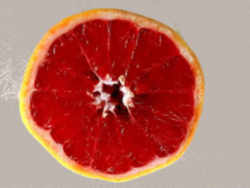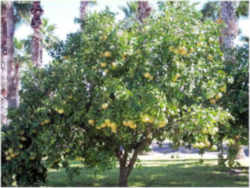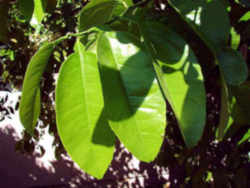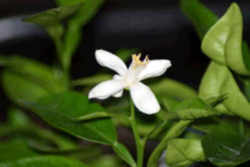
Texas Symbols
Texas State Fruit
Texas Red Grapefruit

(Citrus Paradisi)
Adopted on May 17, 1993
The Texas red grapefruit, (Citrus Paradisi,) was designated the official state fruit by the 73rd Legislature in 1993 and signed by Governor Ann Richards on May 17, 1993. Texas red grapefruit is grown in the Lower Rio Grande Valley.
The first reported planting of a grove in Texas was 1893. Initial grapefruit plantings in Texas were the white varieties, followed by pink varieties.
Texas produces the following trademarked categories of grapefruit:
Ruby-Sweet?
Includes the famous Ruby Red, and other redder varieties - Henderson and Ray. Its smooth, yellow skin is naturally tinged with a reddish blush, and
an interior color 3 to 5 times redder than the Ruby Red.
Rio Star?
Combines the two reddest varieties - Rio Red and Star Ruby grapefruit. It has an overall blush on the exterior peel with a deep red interior color
which is 7 to 10 times redder than the Ruby Red.
Flame
Red but not too red, with the same sweet, delectable taste as the Ruby-Sweet and Rio Star. Available at certain times from October through May.
Texas State Fruit: Texas Red Grapefruit
History of the Grapefruit

The origin of the grapefruit, also known by the Latin name, Citrus Paradisi, is somewhat obscure. It is thought that the grapefruit
was first found in Barbados during the 1750's as a mutation of the pummelo. Years later, research confirmed that grapefruit is a hybrid of a pummelo
(citrus grandis), and the sweet orange (citrus sinensis). Originally known as "the forbidden fruit", it wasn't until the 1800's that a Jamaican farmer
called the fruit "grapefruit" for the grape-like cluster in which it grows on trees. During this time, it's believed that grapefruit made its way to
the United States in the form of seeds brought by either Spanish or French settlers to Florida. Eventually, grapefruit made its way to South Texas,
most likely by visiting Spanish missionaries.
 The first reported planting
of a grove in Texas was 1893. Initial grapefruit plantings in Texas were the white varieties, followed by pink varieties. John H. Shary, a developer
originally from Omaha, Nebraska, was so impressed by the small crop raised by early citrus experimenters that he felt citrus was the crop of the future
for Texas. Shary, also known as the "Father of the Citrus Industry", combined his interest in growing citrus with the latest irrigation techniques
and a determination to sell valley citrus commercially. In 1914, he bought 16,000 acres of brush land and after clearing it, proceeded to grow his
first crop of seeded white grapefruit.
The first reported planting
of a grove in Texas was 1893. Initial grapefruit plantings in Texas were the white varieties, followed by pink varieties. John H. Shary, a developer
originally from Omaha, Nebraska, was so impressed by the small crop raised by early citrus experimenters that he felt citrus was the crop of the future
for Texas. Shary, also known as the "Father of the Citrus Industry", combined his interest in growing citrus with the latest irrigation techniques
and a determination to sell valley citrus commercially. In 1914, he bought 16,000 acres of brush land and after clearing it, proceeded to grow his
first crop of seeded white grapefruit.
The first commercial shipment of citrus - packed in onion crates - left the Lower Rio Grande Valley of South Texas in 1920. It was about the time of
the great stock market crash in 1929 when an accidental discovery of red grapefruit growing on a pink grapefruit tree gave rise to the Texas Red Grapefruit
Industry. In the late 1920's and early 1930's redder bud mutations were found in numerous groves. Each new finding was named for the grower who found
it.
 With several red grapefruit
varieties and names being shipped commercially, keeping track of it soon became a marketing problem. So all the red varieties of fruit started being
marketed under the name "Ruby". The "Ruby" Red Grapefruit was the first grapefruit to be granted a US patent. Following freezes in 1949, 1951, and
1962, Texas eliminated its white and pink varieties, and set out to establish its reputation for growing the red grapefruit. During the 1970's, several
important mutations found on the "Ruby" trees produced fruit even redder than the 1929 Ruby Red grapefruit. Each finding again took the name of the
grower who discovered it.
With several red grapefruit
varieties and names being shipped commercially, keeping track of it soon became a marketing problem. So all the red varieties of fruit started being
marketed under the name "Ruby". The "Ruby" Red Grapefruit was the first grapefruit to be granted a US patent. Following freezes in 1949, 1951, and
1962, Texas eliminated its white and pink varieties, and set out to establish its reputation for growing the red grapefruit. During the 1970's, several
important mutations found on the "Ruby" trees produced fruit even redder than the 1929 Ruby Red grapefruit. Each finding again took the name of the
grower who discovered it.
Dr. Richard Hensz of the Texas A&I Citrus Center (now known as the A&M Citrus Center) spent many years in the laboratory, working to produce
the reddest grapefruit through mutations induced by ionizing radiation. In 1970 the Star Ruby variety was released followed by the Rio Red variety
in 1984. With so many red varieties with varying degrees of redness, the industry was again faced with a marketing dilemma. To differentiate the Texas
sweet, red grapefruit - a superior tasting grapefruit - from those other grapefruit, the industry now markets its fruit under two registered trademarked
categories: Ruby-Sweet and Rio Star.
The South Texas sub-tropical climate, fertile soil, and sunny weather work together to provide excellent growing conditions unique to the area. Texas
citrus growers carefully maintain crop quality through successful irrigation techniques, growing conditions and extensive research. Texas grapefruit
is tree-ripened and hand-picked to ensure the best quality possible. After picking, area shippers wash, inspect, grade and hand-pack the fruit. It's
then shipped to supermarkets across the United States. and Canada.
Characteristics of the Grapefruit
A fairly new citrus, grapefruit is believed to be a cross between a pummelo and an orange.The grapefruit family includes white, red (sweeter than white), pummelo (father of the grapefruit and the largest citrus), minneola (cross between tangerine and grapefruit), and sweeties (cross between the pummelo and the grapefruit).
Texans have grown grapefruit in the Rio Grande Valley for about 100 years. Around 1929 a mutation on a single tree became the famed Texas Ruby Red, which received the first-ever patent awarded to a grapefruit
The evergreen grapefruit trees usually grow to around 5-6 meters (16-20 ft) tall, although they can reach 13-15 m (43-49 ft). The leaves are glossy dark green, long (up to 15 centimeters (5.9 in)) and thin. It produces 5 cm (2 in) white four-petaled flowers. The fruit is yellow-orange skinned and generally an oblate spheroid in shape; it ranges in diameter from 10-15 cm (3.9-5.9 in). The flesh is segmented and acidic, varying in color depending on the cultivars, which include white, pink and red pulps of varying sweetness (generally, the redder varieties are sweeter). The 1929 US Ruby Red (of the Redblush variety) has the first grapefruit patent.
Leaf: Alternate, simple, evergreen, entire or toothed, the petioles often winged, aromatic when crushed, dark and shiny above, paler below.
Flower: Fragrant, white, usually 5 long petals.
Fruit: Generally round or oval, covered in a leathery skin, fragrant, the fleshy inside segmented. Included in this genus are the familiar and edible oranges, grapefruits, lemons, limes, and tangerines.
Twig: New growth is usually green and armed with sharp stiff thorns.
Bark: Generally thin and tight, gray-brown to red-brown, variously lined or grooved.
Form: Small trees or shrubs with spreading crowns.
Texas House Concurrent Resolution No. 75, 73rd Legislature, Regular Session (1993)
H.C.R. No. 75
HOUSE CONCURRENT RESOLUTION
WHEREAS, The State of Texas has traditionally recognized a variety of official state symbols as tangible representations of the proud spirit and heritage
of our state; and
WHEREAS, The bluebonnet, the pecan tree, and the mockingbird are examples of natural specimens that serve to exemplify the great diversity of the Texas
landscape, while the state dish, chili, fittingly represents another aspect of our shared culture as Texans; and
WHEREAS, In keeping with this custom, the designation of the Texas Red Grapefruit as the official State Fruit of Texas will provide suitable recognition
for this outstanding food resource; and
WHEREAS, First discovered by Texas citrus growers in 1929, this variety of grapefruit has been carefully nurtured and perfected over time and is renowned
for its sweetness and rich, red interior; and
WHEREAS, As nutritious as it is palate-pleasing, the Texas Red Grapefruit contains no fat or sodium, lowers high levels of blood cholesterol, boosts
iron absorption, is low in calories, and is rich in vitamin C; and
WHEREAS, This delicious fruit also is a boon to the state economy, generating more revenue than any other tree fruit produced within our borders; and
WHEREAS, As distinctive as the proud state from which it originates, the Texas Red Grapefruit will serve as a fitting emblem for the bounties of nature
with which our state is blessed; now, therefore, be it
RESOLVED, That the 73rd Legislature of the State of Texas hereby designate the Texas Red Grapefruit as the official State Fruit of Texas.
Texas Law
Because the Texas Red Grapefruit was adopted by House Concurrent Resolution, it is not listed in the Texas Statutes.
Taxonomic Hierarchy: Grapefruit
Kingdom: Plantae - Plants
Subkingdom: Tracheobionta - Vascular plants
Superdivision: Spermatophyta - Seed plants
Division: Magnoliophyta - Flowering plants
Class: Magnoliopsida - Dicotyledons
Subclass: Rosidae
Order: Sapindales
Family: Rutaceae - Rue family
Genus: Citrus L. - citrus
Species: Citrus xaradisi Macfad. (pro sp.) [maxima x sinensis] - grapefruit

List Official US State Foods






